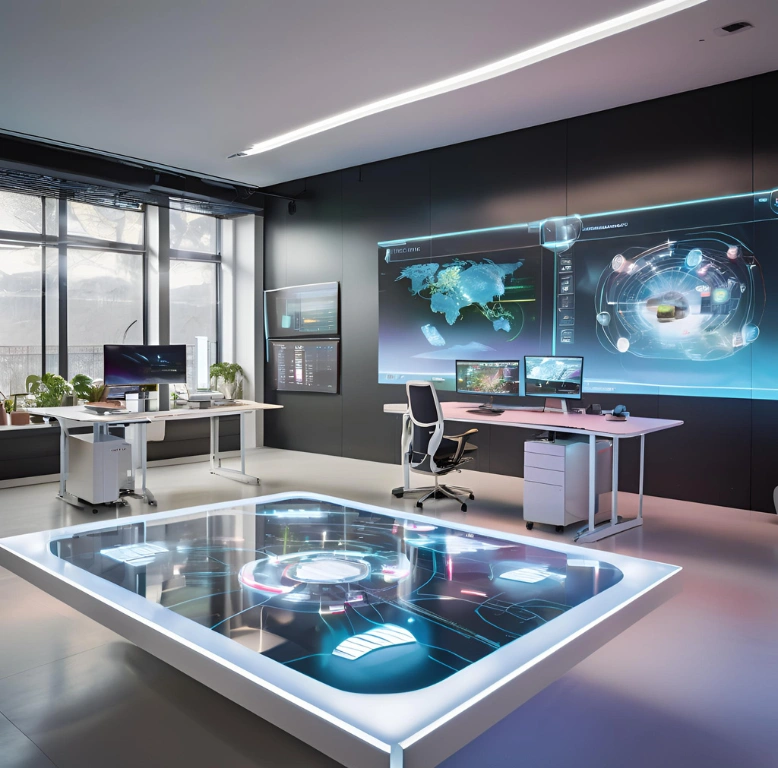
Augmented Reality (AR) and Virtual Reality (VR) are no longer just futuristic technologies; they’re part of our reality, enabling you to take your business to a digital level. Whether enhancing marketing campaigns, improving training programs, or creating more immersive customer experiences, AR and VR can revolutionize the way you operate.
But why and how are AR and VR gaining traction with businesses of all types? In this article, we’ll explain their benefits, applications, and practical examples to help you understand how these technologies can fit into your business strategy.
What Are AR and VR?
Let’s start by breaking down these digital terms in a simple way.
Chances are you’ve seen virtual reality glasses online or in ads. That’s VR in action, almost. If it hasn’t caught your eye yet, here’s an explanation: augmented reality (AR) is like adding a digital layer over what you see in real life.
Imagine holding up your phone and seeing a new sofa virtually placed in your living room, perfectly suited in size and style. Pretty cool, right? That’s AR at work. It enhances your surroundings with interactive, computer-generated images or information. You can use AR with a smartphone, tablet, or specialized AR glasses.
Now, let’s look at the magic behind it AR software seamlessly blends real and digital worlds. AR is a perfect tool in retail, helping customers make informed decisions without stepping into a store.
Virtual Reality (VR)
When you put on a VR headset, you’re no longer in your living room — instead, you might be exploring a museum, undergoing training on a simulated factory floor, or joining a virtual meeting. The experience feels incredibly real because you’re fully immersed in a computer-generated environment that engages all your senses. There are different types of VR: from fully immersive systems, where you feel completely surrounded by a digital world, to semi-immersive solutions used for professional training. These types address different needs, whether it’s a learning module for pilots or a simple VR game for relaxation.
Real-Life Examples
AR and VR are more than just fun tech gadgets — they’re powerful tools being used across industries to grow businesses. Here are some examples of how companies are benefitting from corporate VR and AR projects.
VR in Training
One prominent example is using VR to train pilots. VR modules allow pilots to practice in a simulated environment that mimics real conditions, helping them refine their skills without risk. Similarly, surgeons use VR to rehearse complex procedures, preparing themselves for the operating room. These VR applications are game-changers in fields where precision is key.
AR in Design and Manufacturing
Industries like automotive use AR to improve design processes. For example, engineers can visualize and interact with 3D models of cars, spotting potential design flaws before they become costly problems. This approach extends to safety protocols, where AR in business helps employees see step-by-step maintenance guides on the machines they’re working on.
AR in Retail
AR is booming in retail. Retailers use AR to help shoppers visualize products before purchasing. For instance, fashion brands let customers “try on” clothing via phone, and furniture stores like IKEA offer AR apps that let you place virtual furniture in your space to check size and style. This practical use of AR services not only makes shopping more enjoyable but also boosts buyers’ confidence in their purchases.
These real-world applications of AR and VR demonstrate just how versatile new technologies can be. They’re not just flashy novelties they’re practical tools that address real business challenges, make processes more efficient, and improve customer experiences. Whether it’s a VR company aiming to train employees more effectively or a retail chain seeking to increase customer engagement through AR ads, the potential is vast.
The Role of AR and VR in Business
Transforming Marketing and Advertising Now, let’s take a closer look at how AR and VR are changing the world of marketing and advertising. Say you’re browsing online for a new piece of furniture, wondering if it will match your curtains or fit in a narrow corner. Imagine, instead of “guessing,” you could “place” the item in your room. Of course, AR allows you to do this with a smartphone or tablet.
It’s not just you this technology is accessible to potential customers too. Today, using innovative technology helps customers make more confident decisions and reduces issues with product returns—a win-win for both customers and businesses.
Where Else Can You Find AR?
Cosmetic brands quickly adopted augmented reality software, allowing shoppers to virtually try on products. Now, with an app, any user can easily see how a certain shade of foundation or lipstick will look on their face without touching the product or leaving home. AR makes online shopping easier and more reliable, especially for people who hesitate to try new products without testing them first.
Whether it’s AR in marketing strategies or VR in business, these technologies aim to improve user interaction and add value. In today’s competitive market, companies that invest in these technologies are more likely to stand out.
The Benefits and Challenges
While the advantages of virtual and augmented reality in business are impressive, let’s consider the bigger picture. One of the greatest benefits is that these technologies can create a stronger connection with customers and open up new interaction opportunities. From improving customer satisfaction in retail to more effective marketing campaigns, integrating AR and VR into your business strategy has plenty of appeal.
Challenges to Consider
Initial investment costs in VR companies or custom AR software development can be substantial. Additionally, ensuring accessibility and ease of use for all is essential. Despite these “obstacles,” the long-term benefits of virtual reality and AR typically outweigh initial investments, especially for companies striving to be ahead of the curve.
ROI and Customer Engagement
Let’s talk about numbers and customer satisfaction because, ultimately, the goal is to grow business. Companies that integrate AR and VR often see a noticeable return on investment. Why? Immersive and interactive experiences make customers feel more connected to the brand and its products, increasing engagement and loyalty.
For example, VR applications in real estate have simplified and enhanced the home-buying process. Instead of physically visiting 10 different properties, potential buyers can take virtual tours from their couches. Likewise, the travel industry—specifically hotels—uses VR to give potential guests a virtual experience of amenities and rooms, allowing them to make quicker and more confident bookings.
From improving training programs and reducing operational costs to strengthening customer relationships, AR and VR should be considered tools for enhancing efficiency and engagement. Additionally, as more companies adopt these technologies, the AR and VR services market continues to expand, making it easier than ever to find solutions that fit your business needs.
Implementing AR and VR in Your Business
Before diving in, start by partnering with a reliable VR solutions provider or AR services company. Specialists will be available to help you explore available options and configure the technology to suit your unique business needs.
Begin by identifying what you want to achieve. Are you looking to increase customer engagement, improve employee training, or optimize operations? Defining goals will help you select the right technological solutions that match your vision. Whether interactive training modules for staff or exciting shopping experiences for customers, the right partner can bring your ideas to life.
Conclusion
If you want to add a “wow factor” and make a lasting impression on your customers, using VR in business and AR in marketing strategies could be your next big move. The opportunities are growing, and those who act early are likely to gain the most benefit.
FAQ
- How Does Virtual Reality Work?
Virtual Reality (VR) creates an immersive, computer-generated environment that fully engages the senses, making users feel as though they’re in a different location or setting. This is achieved through a VR headset, which displays realistic 3D visuals and uses motion sensors to track head and body movements.
- How Is Augmented Reality Used in Businesses?
Augmented Reality (AR) overlays digital information onto the real world, enriching the user experience and providing additional value to everyday tasks. In businesses, AR is widely used to enhance customer engagement, streamline processes, and improve decision-making. For example, in retail, AR lets customers try on clothes or visualize furniture in their own spaces before purchasing.
Subscribe to our blog

